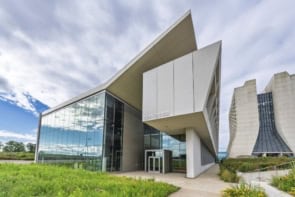
Engineers at CERN are making the final touches to the Large Hadron Collider (LHC) — the biggest experiment in particle physics — and expect to have it running in the first half of July. Although the start-up schedule of the European particle accelerator has slipped by over a month since the last official announcement, there appear to be only minor problems left to resolve.
“It has been some time since we’ve been in this kind of position with this kind of research facility,” says James Gillies, a spokesman for CERN. “There’s real confidence that we’ll be collecting new data this year. It’s a very big time for us.”
When all is done and dusted, the LHC will have cost around $6.3bn to build. Some 6000 superconducting magnets will whip proton beams in opposite directions around a 27 km-long ring and smash them together at energies bordering on 14 TeV. The impacts will generate a hoard of new particles, possibly including the highly anticipated Higgs particle and so-called supersymmetric particles. But regardless of what is or is not detected, it is almost certain that the LHC will provide a window onto new physics.
Until recently, the official line from CERN was that the first proton beams would be injected into the ring in May, despite status reports from the LHC website suggesting otherwise. According to Gillies, previous problems have now compelled CERN to set back the start up to the first half of July. An official date will be announced sometime after mid-June, the earliest time that all the magnets can be cooled to their operating temperature of below 2 K.
There’s real confidence that we’ll be collecting new data this year. It’s a very big time for us James Gillies, CERN spokesman
Latent problems
The main problem that has dogged the LHC start-up schedule of late erupted with a bang this time last year, when one of the “quadrupole” magnets used to focus and manipulate the proton beams failed during preliminary tests. Fermilab, the US laboratory who manufactured the magnets, was quick to accept responsibility, but it soon became apparent that all similar magnets would have to be redesigned and replaced. CERN is still reeling from this overhaul, having had to delay the cooling of magnets and skip the low-energy test runs that were due to take place before winter.
There have since been other, less serious problems. Towards the end of last year CERN found that certain “copper fingers” used to ensure electrical continuity between magnets had buckled when the magnets were warmed up. Presently, LHC engineers are having a few difficulties with leaky plumbing of liquid helium, which is used to cool the magnets. “Superfluid helium has no viscosity, so it can find any cracks,” explains Gillies.
Even though proton beams will not enter the LHC before July, by May 21 the beams will be running through two of CERN’s existing particle accelerators, which are serving as preliminary accelerator stages. The Proton Synchrotron, built in the late 1950s, will speed the protons up to 25 GeV and feed into the Super Proton Synchrotron, built in the 1970s, to get them up to 450 GeV.
Wide media coverage
On the day when the LHC is ready to have its proton beams injected, onlookers can expect wide media coverage. According to Gillies, they will inject the first beam in one direction at 9:30am (central-Europe time) to tie in with a live broadcast from BBC Radio 4’s Today Programme. Visuals will show the beam’s progress while CERN scientists analyse it. Every 10 minutes, they will be able to send in another beam. “Hopefully we’ll get one circulating all the way round by the end of the day,” says Gillies. Once they have understood the circulation in one direction, the scientists will begin experimenting with counter-circulating beams. “Then we’ll ramp up the energies,” he adds.
In light of the huge public interest in the LHC, CERN is holding an open day for the accelerator on April 6. From April 2–7 the lab is also allowing US high-school students to visit and report back their experiences via blogs and videos.
It appears that the pangs of excitement are beginning to be felt at CERN. Still, few of those involved are counting their chickens just yet. “We have to cool the whole machine down first,” says LHC project leader Lyn Evans. “I hope that that can be achieved by mid-June so we can start taking data in July.”



